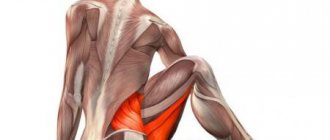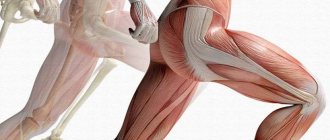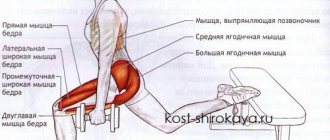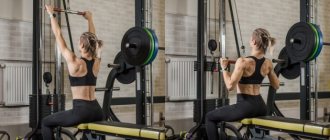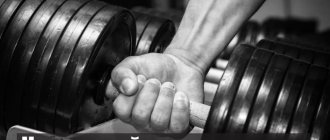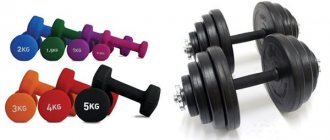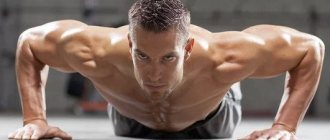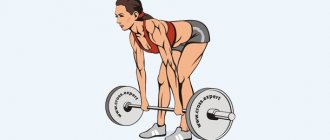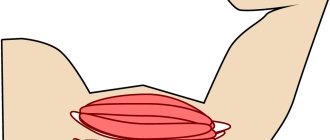Content
- 1 Deltoid muscle, clavicular part 1.1 Beginning
- 1.2 Attachment
- 1.3 Innervation
- 1.4 Training
- 1.5 Features
- 1.6 Shoulder flexion/adduction. Functional muscle tests
- 1.7 Participation in sports
- 2.1 Beginning
- 3.1 Beginning
Deltoid muscle, acromial part[edit | edit code]
Deltoid muscle, acromial part
Home[edit | edit code]
- Akromion
Attachment[edit | edit code]
- Deltoid tuberosity of the humerus
Innervation[edit | edit code]
- Axillary nerve, C5-C6
Features[edit | edit code]
The acromial part of the deltoid muscle (m. deltoideus) forms the relief of the lateral part of the shoulder girdle. When lifting heavy objects, it holds the head of the humerus in the glenoid cavity of the scapula.
| Functions | Synergists | Antagonists |
| Shoulder abduction (with the arm already abducted) | *M. deitoideus (spinous and clavicular parts with the arm already abducted) *M. infraspinatus (cranial part) *M. biceps brachii (long head) | *M. pectoralis major *M. latissimus dorsi *M. teres major *M. teres minor *M. coracobrachialis *M. biceps brachii (short head) *M. deitoideus (clavicular and spinous parts with the arm already adducted) *M. infraspinatus (caudal part) *M. triceps brachii (long head with arm already abducted) |
Shoulder abduction. Functional muscle tests[edit | edit code]
Issues and comments
- Do not allow the patient to externally rotate the arm, as this will engage the biceps brachii muscle.
- When testing the acromial deltoid, ensure that the patient does not elevate the shoulder or tilt to the opposite side, as this may appear to be shoulder abduction.
- The supraspinatus muscle serves as an assistant to the acromial part of the deltoid muscle.
Participation in sports[edit | edit code]
The acromial part of the deltoid muscle is involved in all sports that require abduction of the upper limb from the starting position (fencing, weightlifting) or holding the shoulder in an abducted position (archery, rifle shooting). This muscle plays an important role in all types of swimming, especially crawl and butterfly. When doing weightlifting, it centers the head of the humerus in the glenoid cavity of the scapula.
| Kind of sport | Movement/hold | Function | Load | Types of abbreviations |
| Fencing | Lunge | Shoulder abduction | Fast, explosive | Dynamic concentric |
| Weightlifting | Thrust phase | Shoulder abduction | Fast, explosive, maximum | Dynamic concentric |
| Handball | Throw | Shoulder stabilization | Fast | Dynamic concentric |
| Thrust phase | Stabilization of the humeral head in the glenoid cavity | Fast | Dynamic concentric | |
| Archery | Bowstring tension and aiming | Stabilization of the upper limb in abduction position | Strength endurance | Static |
| Rifle shooting | Stabilization of the upper limb in the shooting position | Stabilization of the upper limb in abduction position | Strength endurance | Static |
| Swimming | Breaststroke, backstroke - carry phase | Shoulder flexion, shoulder abduction | Strength endurance | Dynamic concentric |
| Swimming crawl or butterfly - carry phase | Shoulder abduction | Strength endurance | Dynamic concentric |
Anatomy of deltas (shoulders)
The deltoid muscles, also known as the shoulder muscles, have THREE PARTS:
- front;
- lateral (middle);
- back;
Each part (each bundle) performs its functions:
- Front delta – raises the lowered arm up, bends the shoulder, while simultaneously turning it inward.
- Rear delta – lowers the raised arm down, straightens the shoulder, while simultaneously turning it outward.
- Lateral (middle) delta – moves the arm to the side. When the entire muscle contracts, it abducts the arm approximately 65-75 degrees.
Is it difficult to build huge shoulders? It would seem that what could be difficult? Just increase the weights and your shoulders will grow. After all, the deltoids, although not such large muscle groups as the legs, chest or back, are capable of generating impressive force. Not so simple.
The deltoids are very “delicate” muscles, so they are easily injured. The shoulder joint, in the human body, is the MOST MOBILE joint, so it is less stable. It has much more degrees of freedom.
Depending on which bundle of deltoid muscles is included in the work, the shoulder joint can raise the arm up or move it back, as well as turn the shoulder inward or outward.
Read more: Diet and nutrition on a steroid cycle
Traditionally, the delta is divided into three bundles (as I said above), but it would be much more logical to divide them into two bundles. What is this connected with?
Our deltoids can be trained with both presses and rows.
The FRONT BAND of deltas is responsible for pressing movements, and the REAR BAND is responsible for traction movements.
THE MIDDLE BAND of deltoid muscles is HYBRID, i.e. responsible for both types of movements, although it would still be more logical to classify it as traction, because he grows better from flyes and barbell rows to the chin than from bench presses.
A beautiful, aesthetic, athletic physique implies a V-shape. Just to achieve this shape it is necessary to develop broad shoulders. Thus, visually the back appears more massive and the waist is narrower.
Read also[edit | edit code]
- Muscles - anatomy and functions
- Muscles of the shoulder girdle
- Arm muscles
- Shoulders - exercises and training features
- Anatomy of the shoulder joint
- Trapezius muscle
- Levator scapulae muscle
- Rhomboid muscles
- Serratus anterior muscle
- Supraspinatus muscle
- Infraspinatus muscle
- Subscapularis muscle
- Latissimus dorsi muscle
- Teres major muscle
- Teres minor muscle
- Pectoralis major muscle
- Pectoralis minor muscle
- Subclavius muscle
- Coracobrachialis muscle
Deltoid. Detailed description and pumping methods
Before moving on to the article, I would like to draw your attention to this service for athletes. The virtual rocking chair is a godsend for beginners. All the advanced training principles are so organically and competently woven into the training programs that I regret that such a service did not exist when I myself was a beginner.
The deltoid muscle (lat. musculus deltoideus) is a large, powerful superficial muscle of the shoulder; resembles the Greek letter delta (triangle), hence its name. The triangle has its base up and its apex down. The muscle begins with a tendon from the outer part of the clavicle, then from the acromion and from the lower part of the crest of the scapula. The muscle covers the connection of the humerus with the scapula, then passes into a tendon that is attached to the roughness on the front surface of the humerus near its middle.
For those who want to receive the most complete information about pumping and description of each human muscle, I advise you to go to the page of my blog MUSCLES
The deltoid muscle consists of three bundles (heads):
- anterior (clavicular)
- middle (shoulder)
- posterior (scapular)
Deltoid function:
- The clavicular bundle raises the arm forward;
- The shoulder raises the arm to the side;
- The scapular band raises the arm back.
The development of the deltoid muscle makes a person's shoulders wider. If you need to increase the width of your shoulders and give them a beautiful shape, you need to “pump up” the deltoid muscles. To stimulate the deltoid muscle, it is necessary to involve as many muscle fibers as possible in the training. Shoulder training is a difficult task, since amateurs often, instead of developing the middle and posterior delta bundles, begin to intensively pump the anterior bundle and thereby heavily load the clavicular bundle. At the same time, the shoulders remain unpumped. To prevent this situation, you should strictly follow the given exercises with mandatory control of all necessary body positions.
When training the deltoid muscle, it is necessary to take into account that when performing exercises on the chest and back muscles, this muscle is also indirectly loaded. Therefore, exercises for this muscle must be strictly planned so as not to overtrain it.
Exercises to develop the deltoid muscle:
Attention: For a more detailed description of exercises for pumping up muscles, read the section “EXERCISE TECHNIQUES”
Exercise 1: “Arnold press”, develops the anterior and lateral muscle bundles. The dumbbells are lowered as far as possible in front of you, your arms must be bent.
Performance:
- Starting position "standing". Bend your arms at the elbows in front of your body. Take dumbbells in your hands and lift them to your shoulders, turn your arms inward with your palms.
- In one movement, smoothly squeeze the dumbbells over your head, without going all the way, and at the same time lower the dumbbells and rotate your wrists, at the end of the movement your palms should be facing forward.
- Fix the weight, then lower the dumbbells, returning to the starting position, and not forgetting to rotate your arms at the wrists. Don't focus too much on squeezing the dumbbells over your head, otherwise your body will start to sway and the effect of the exercise will be minimal. The exercise must be performed with great precision and under complete control. Not fully extending your arms overhead will maintain constant stress on the deltoid muscle. By combining the elements of dumbbell raises in front of the body and dumbbell arm presses, the exercise helps to develop the anterior and middle fascicles of the deltoid muscle.
Exercise 2: Barbell overhead presses, necessary for training the anterior and lateral bundles of the deltoid muscle. When doing presses, the triceps also get a load.
Performance:
It is possible to perform presses in a standing position, but for clearer movements a sitting position is recommended.
- Raise the barbell up with your arms fully extended and lower it onto your shoulders behind your head; it is permissible to remove the barbell from the rack behind your back with a wide grip.
- Press the barbell overhead and lower it as smoothly as possible, straightening your shoulders and moving your elbows back during the movement.
Exercise 3: Dumbbell presses, this exercise trains the anterior and lateral bundles of the deltoid muscle. It may seem that this exercise is identical to the exercise - barbell presses, but there are a number of differences, one of which is the increased range of motion using dumbbells.
Performance:
- Take dumbbells with an overhand grip and hold them at shoulder height with your arms bent.
- Raise the dumbbells until they touch each other at the top point. Then lower it as far as possible.
Exercise 4: Military press, trains the anterior and lateral bundles of the deltoid muscle. This is the basis of all exercises designed to develop the shoulder girdle. In a sitting position, movements will be performed with better clarity than while standing.
Performance:
- In the starting position “sitting” (you can stand), take the barbell with a wide grip and put your palms out for support and hold it at shoulder level.
- From this position, you should raise the barbell above your head until it stops, while not forgetting to monitor your balance. Then smoothly return to the starting position.
Exercise 5: Bench press with a lift from the floor, puts a load on the anterior and lateral bundles of the deltoid muscles. Allows you to effectively build muscle strength and muscle mass.
Raise the barbell off the floor and assume the starting position for a military press. At the beginning of the movement, the leg muscles work, then the trapezius muscles, muscles of the shoulder girdle and arms begin to work, which contributes to the effective development of the largest muscle mass.
Performance:
- You need to squat down, lean forward and grab the barbell with an overhand grip, placing your hands shoulder-width apart.
- Straighten your legs, lift the barbell to shoulder height, then bend back slightly to support the apparatus in the starting position for the military press.
- Using the muscles of the forearm and shoulder girdle, you should press the barbell above your head, then lower it to shoulder height and repeat this movement in reverse order, bending your knees and placing the barbell on the floor.
Exercise 6: Barbell presses on the machine, development of the anterior and lateral deltoid muscles. Presses on the machine allow you to perform movements with greater precision and not lift the barbell off the floor, so as not to accidentally injure your back muscles. In addition, it becomes possible to lower the weight much lower, which allows you to further stretch the anterior head of the deltoid muscle.
Performance:
- Grasp the barbell (or handle) at shoulder level.
- Squeeze the barbell up until it stops, then slowly lower it to the starting position. You can use overhead presses or cross-grip presses when you need to develop the anterior and lateral deltoid muscles.
Exercise 7: Barbell crunches, using more weight than usual or continuing barbell shoulder presses after failure to develop additional muscle strength in the deltoid muscle. This exercise uses the “cheating” principle. You can use it during strength training to lift a barbell that carries more weight than a regular shoulder press. Barbell slings can be used for forced repetitions at the end of a series, when fatigue accumulates and it becomes more difficult to perform shoulder presses with precise movement technique.
Performance:
- Take the barbell with an overhand grip and place your hands slightly wider than shoulder-width apart. The projectile should be held at shoulder level.
- Slightly bend your knees and perform an initial push with your legs so that the barbell goes up. You should use this extra force to press the barbell overhead. Then fix the barbell in the upper position and smoothly lower it to shoulder level.
Exercise 8: Raising straight arms with dumbbells in a standing position to develop the lateral bundle of the deltoid muscle with additional load for the front and rear bundles.
Performance:
- Take dumbbells in each hand, slightly tilt your body forward and extend your lowered arms in front of you. Start each repetition with a clear stop so as not to swing the dumbbells.
- Raise the dumbbells up and at the same time spread them to the sides, turning your wrists slightly, the front of the dumbbells should be lower than the top.
- Raise the dumbbells just above your shoulders, then smoothly and slowly lower them down. A common mistake is swinging your arms back and forth and swinging dumbbells instead of using the deltoid muscle in a controlled, consistent manner. This significantly reduces the effectiveness of the exercise.
Exercise 9: Raising your arms with dumbbells overhead works to develop the posterior and lateral bundles of the deltoid muscles. This exercise also helps develop the trapezius muscles.
Performance:
- Hold dumbbells in each hand and spread your arms out to the sides, palms facing up.
- Slowly raise your arms and bring them above your head. It is not necessary to fully straighten your arms. Make sure that your torso does not sway during the exercise. Having reached the top point, slowly lower the dumbbells to the starting position.
Exercise 10: Alternating arm raises with dumbbells, works to develop the anterior deltoid muscle. This exercise also develops the trapezius muscles in the upper third of the movement. The position for performing can be either “sitting” or “standing”.
Performance:
Standing position, arms with dumbbells down along the body.
- Raise one dumbbell forward and upward in a wide arc above your head.
- Smoothly lower the dumbbell with full control of the movement and simultaneously lift the other dumbbell so that both arms are in motion and the dumbbells move in opposite directions in front of your face. For specific impact specifically on the anterior head of the deltoid muscle, it is necessary to control the movement of the dumbbells, which should pass directly in front of the face, and not to the side. If you perform this exercise with a barbell, grab the bar with an overhand grip. Raise the barbell with outstretched arms and lift it slightly above your head, then return to the starting position.
Exercise 11: Seated dumbbell raises work to isolate and develop the posterior deltoid muscle. When the body is tilted forward, the posterior deltoid muscle works more intensely, and the “sitting” position allows you to perform the exercise with greater clarity.
Performance:
- Sitting on the edge of a bench with your feet together, hold a dumbbell in each hand. Bend your body forward, lower your hands with dumbbells at calf level, turn your palms towards each other.
- Keeping your body still, spread your arms with dumbbells to the sides, turn your wrists so that your thumb is below your little finger. You should control the immobility of the body when raising your arms with dumbbells. Keep your arms slightly bent. Raise the dumbbells slightly with your head, then smoothly lower them to calf level, overcoming resistance. Keep your knees together and lift the dumbbells straight away from you. A common mistake when performing this exercise is to “throw” the dumbbells over your shoulders.
Exercise 12: Standing bent-over dumbbell raises work to develop the posterior deltoid muscles.
Performance:
- Take dumbbells in your hands, tilt your body forward 45 degrees, as much as possible, stretching your arms with dumbbells in front of you.
- Without raising your body, spread your arms with dumbbells. Rotate your wrists so that your thumb is below your little finger (try not to put your hands with dumbbells behind your shoulders). Smoothly lower your arms, overcoming resistance.
Exercise 13: Raising a straight arm with a dumbbell from the stomach from a “lying” position works on the development of the posterior and lateral bundles of the deltoid muscle. This exercise is very effective if performed with moderate weight and strict adherence to movement technique.
Performance:
It is recommended to use an abdominal training bench set at an angle. It is also possible to perform the exercise on a horizontal surface, but this limits the range of movement.
- Lie on your side with your head raised. Holding a dumbbell in one hand. Lower it almost to the floor.
- Raise the dumbbell above your head, keeping your arm straight. Rotate your wrists slightly as you lift so that your little finger is higher than your thumb. This will help the posterior deltoid muscle contract more intensely. After completing the required number of repetitions, turn on the other side and repeat the entire exercise.
If you perform the exercises given here correctly and regularly, then the development of all bundles of the deltoid muscle, and as a result, the beautiful shape of the shoulders, will not take long to happen.
In order to pump up your muscles as effectively as possible and give your body an athletic look, you must not only perform this or that exercise correctly, but also follow a diet, rest properly and take only the necessary sports nutrition. You can read about all this in my free book “Bodybuilding. Build your muscles from other people’s mistakes.”
You may also be interested in the article on how to choose sports nutrition, read it here or material on the topic “dumbbell fly”

